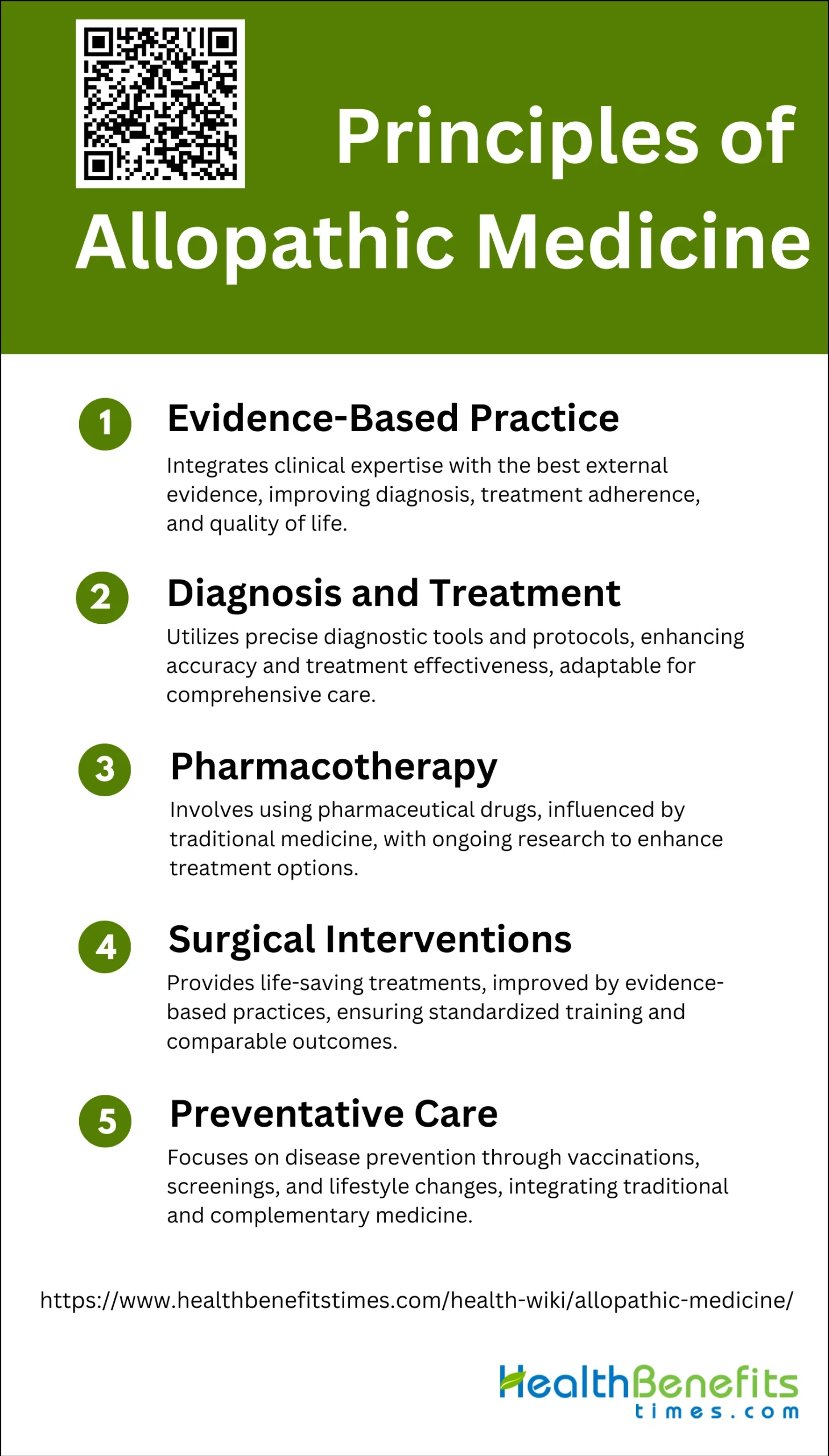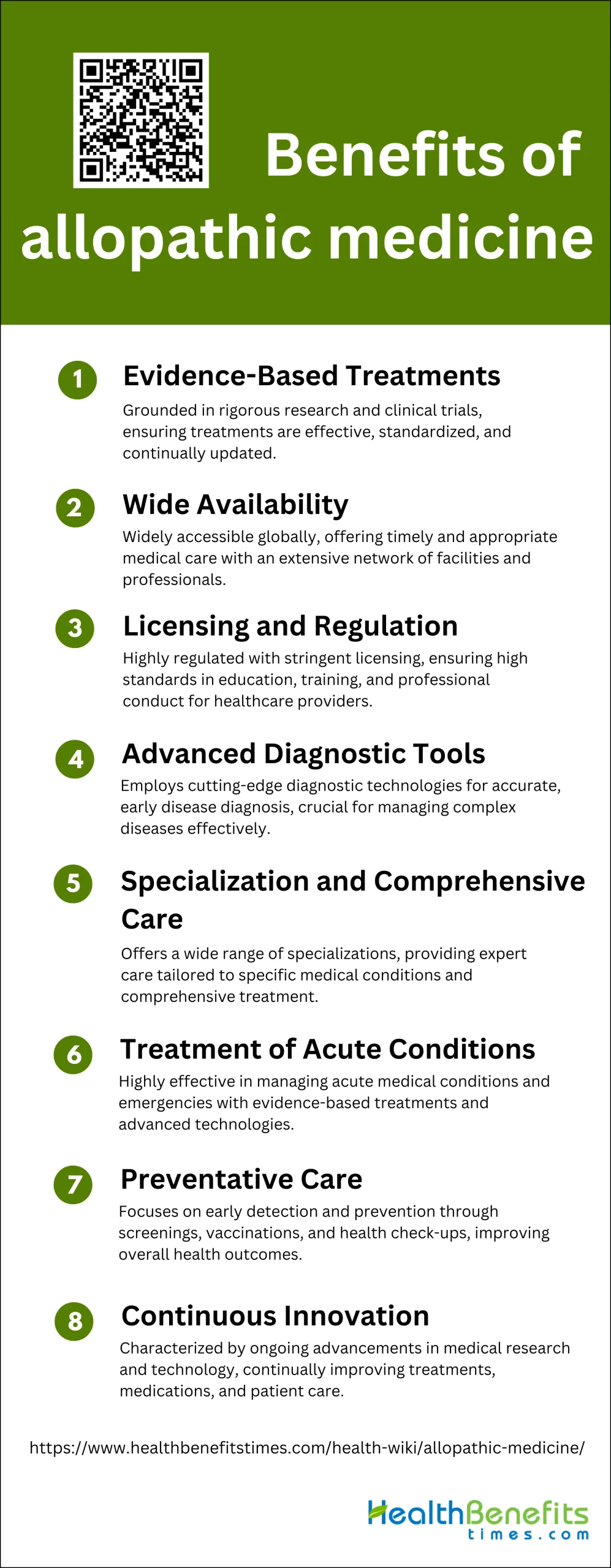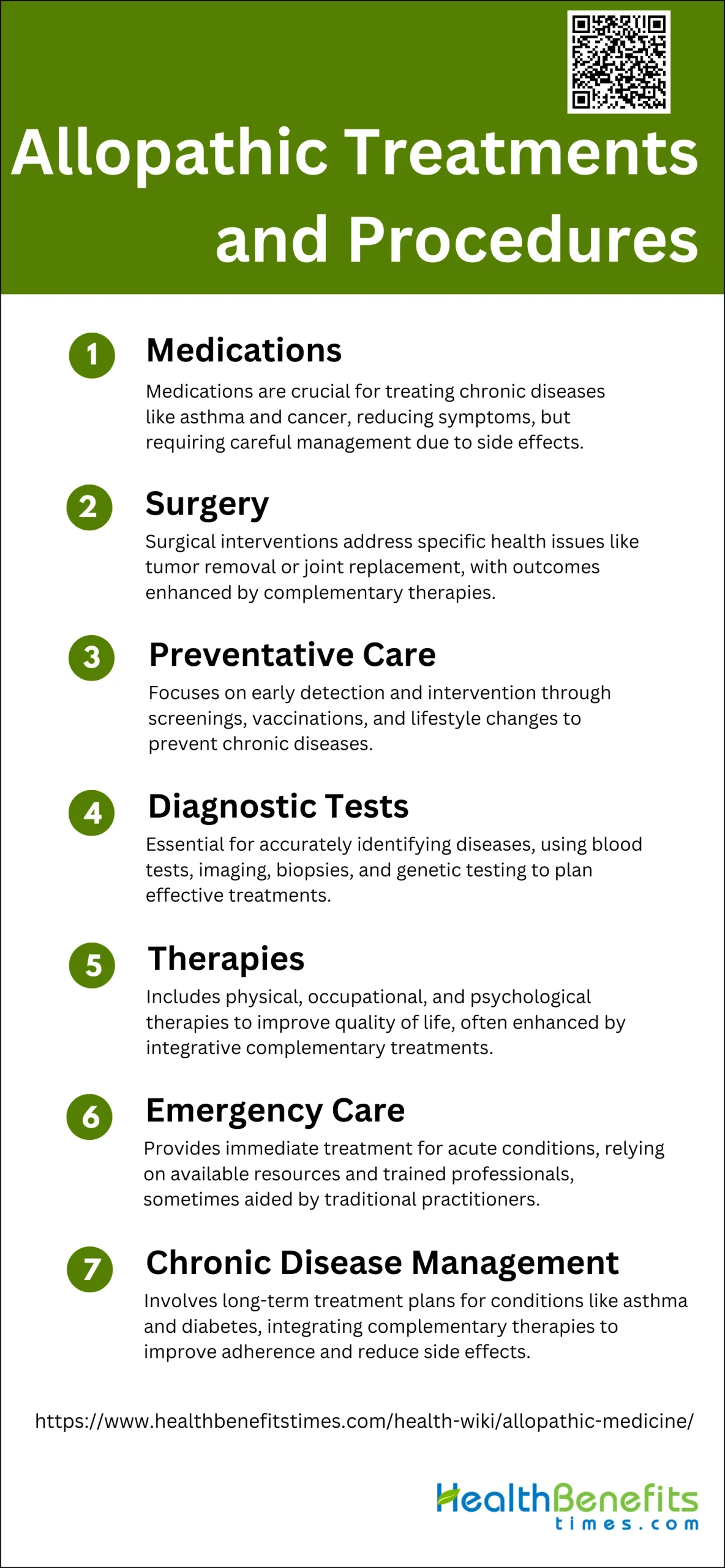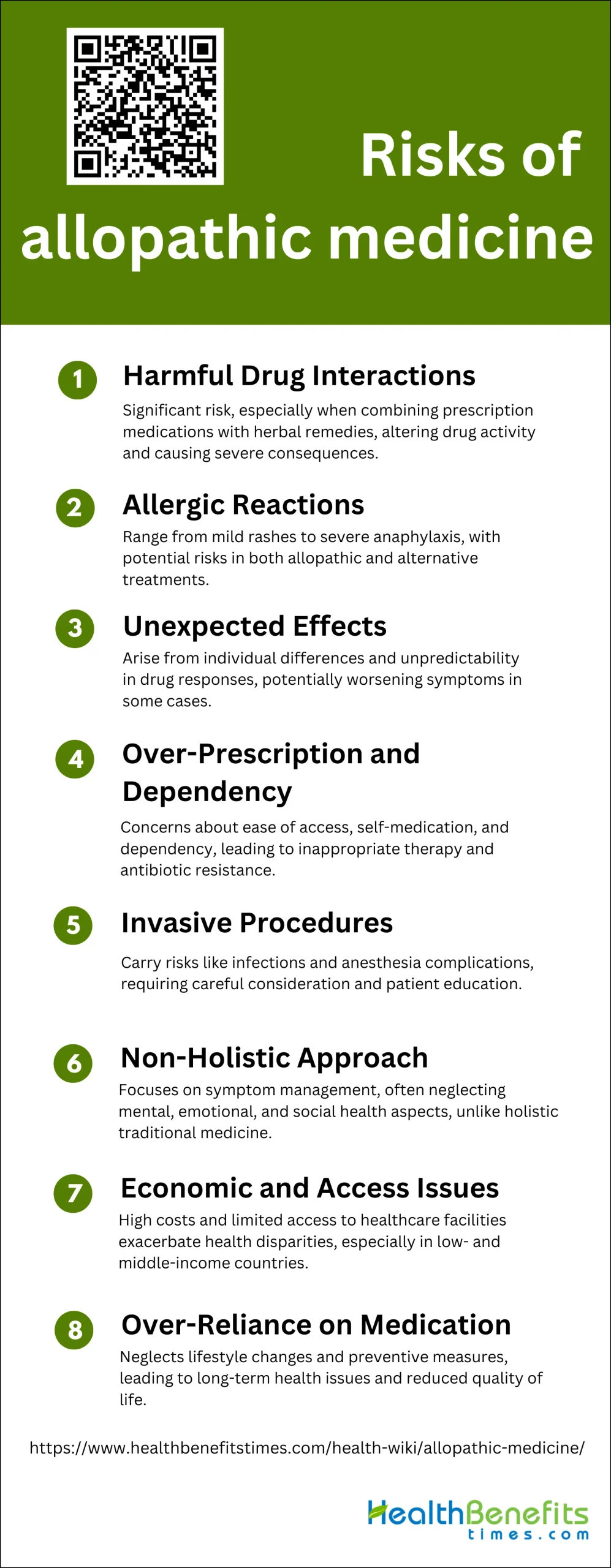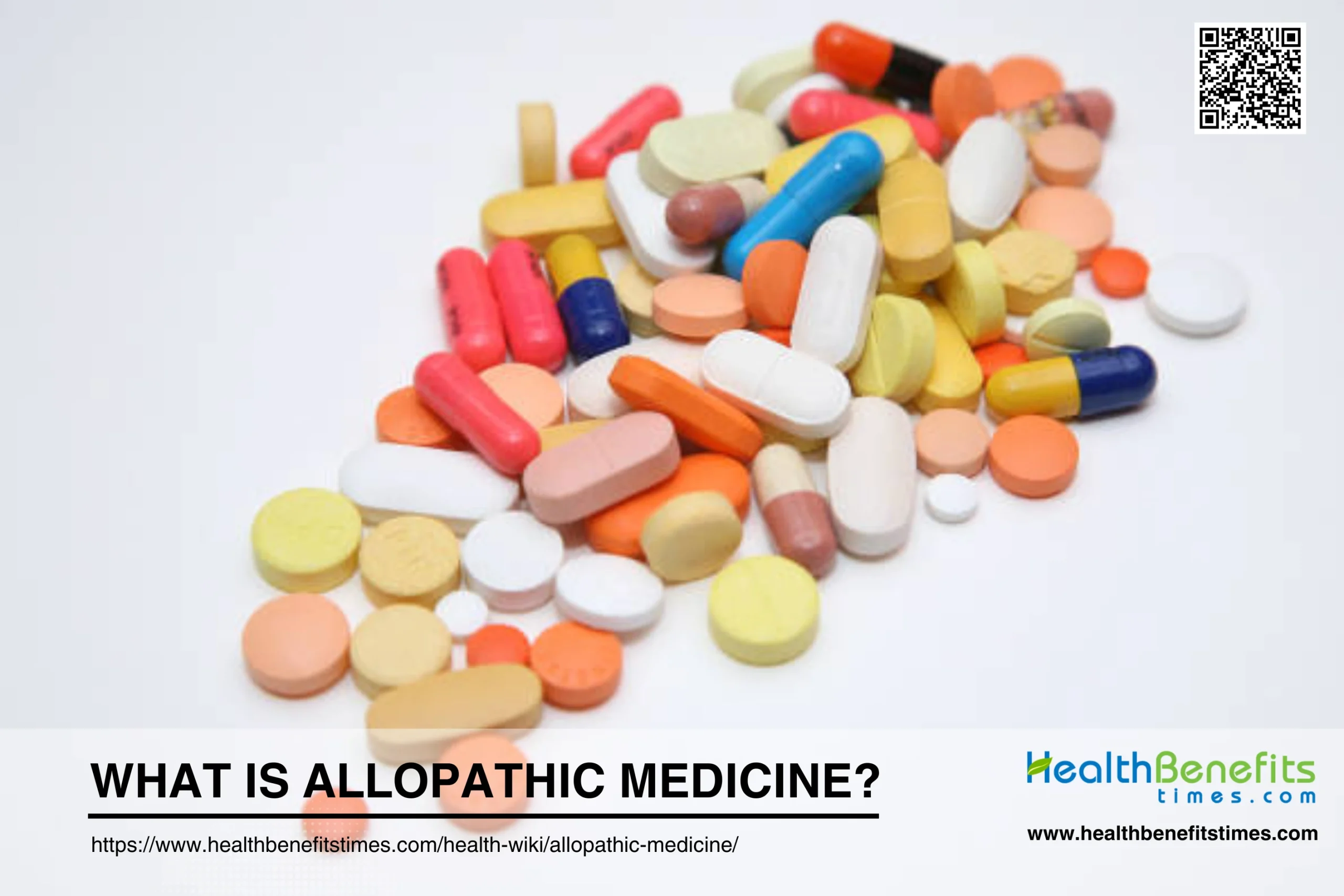 Allopathic medicine, also known as conventional or Western medicine, is a system of medical practice that aims to treat diseases and their symptoms using scientifically proven methods. It is based on the principles of modern science, including biology, anatomy, physiology, and biochemistry. Allopathic medicine relies heavily on the use of pharmacological drugs, surgery, and other invasive procedures to treat diseases and alleviate symptoms. The approach focuses on identifying the underlying cause of a disease or condition and treating it directly, often through the use of synthetic or purified compounds. Unlike traditional or alternative medicine systems, allopathic medicine emphasizes evidence-based practices and rigorous scientific testing of treatments before they are widely adopted.
Allopathic medicine, also known as conventional or Western medicine, is a system of medical practice that aims to treat diseases and their symptoms using scientifically proven methods. It is based on the principles of modern science, including biology, anatomy, physiology, and biochemistry. Allopathic medicine relies heavily on the use of pharmacological drugs, surgery, and other invasive procedures to treat diseases and alleviate symptoms. The approach focuses on identifying the underlying cause of a disease or condition and treating it directly, often through the use of synthetic or purified compounds. Unlike traditional or alternative medicine systems, allopathic medicine emphasizes evidence-based practices and rigorous scientific testing of treatments before they are widely adopted.
History of Allopathic Medicine
Allopathic medicine often referred to as Western or scientific medicine, has a rich and complex history. It entered South Asia as early as the seventeenth century and coexisted with indigenous medical traditions until the mid-nineteenth century when it began to dominate the medical landscape under British colonial rule. The British introduced allopathic medicine in India, which gradually overshadowed traditional systems like Ayurveda and Unani. In the United States, the early nineteenth century saw the rise of alternative medical movements such as Physio-Medicalism, which initially competed with allopathy but eventually declined as allopathic medicine’s science-based approaches proved more effective. The term “allopathy” itself, originally coined by Samuel Hahnemann, the founder of homeopathy, described a method of treating disease by producing effects opposite to the symptoms. Over time, allopathic medicine evolved significantly, incorporating scientific advancements and establishing itself as the dominant medical paradigm globally.
Principles of Allopathic Medicine
It is based on several core principles that guide its practice. These principles emphasize evidence-based treatments, the use of pharmaceuticals and surgical interventions, and a systematic approach to diagnosing and managing diseases. Below are the key principles of allopathic medicine:
1. Evidence-Based Practice
Evidence-based practice is a cornerstone of allopathic medicine, emphasizing the use of current best evidence in making decisions about the care of individual patients. This approach integrates clinical expertise with the best available external clinical evidence from systematic research. For instance, the integration of traditional and allopathic medicine in cancer care has shown that evidence-based integration can improve diagnosis, treatment adherence, and health-related quality of life for patients. Similarly, the osteopathic profession is increasingly aligning with evidence-based practices to ensure patient-centered care that is both culturally sensitive and scientifically sound.
2. Diagnosis and Treatment
Allopathic medicine relies heavily on precise diagnostic tools and treatment protocols to manage diseases. The application of genetic principles in diagnosing complex clinical entities has significantly enhanced the accuracy of allopathic medicine, allowing for more effective treatment plans. For example, the integration of osteopathic manipulative treatment (OMT) into allopathic family medicine has shown that even a short elective can equip allopathic residents with the skills needed to manage musculoskeletal problems effectively. This highlights the adaptability and comprehensive nature of allopathic diagnostic and treatment methodologies.
3. Pharmacotherapy
Pharmacotherapy is a fundamental aspect of allopathic medicine, involving the use of pharmaceutical drugs to treat various conditions. The historical development of pharmacotherapy has been influenced by traditional medicine, with many modern drugs originating from natural products. For instance, aspirin and morphine, commonly used in allopathic medicine, have roots in traditional remedies. The ongoing research into the mechanisms of homeopathic medicines also aims to integrate these principles into mainstream medical practices, potentially enhancing pharmacotherapy options.
4. Surgical Interventions
Surgical interventions are a critical component of allopathic medicine, often providing life-saving treatments for various conditions. The evolution of surgical techniques and the incorporation of evidence-based practices have significantly improved patient outcomes. For example, the quality of care provided by allopathic and osteopathic physicians in surgical settings has been shown to be comparable, with no significant differences in patient outcomes or healthcare costs. This underscores the importance of standardized training and evidence-based practices in surgical interventions.
5. Preventative Care
Preventative care is a key principle of allopathic medicine, focusing on measures to prevent diseases before they occur. This includes vaccinations, screenings, and lifestyle modifications. The integration of traditional medicine into allopathic practices can enhance preventative care, especially in regions where traditional practitioners are more accessible. Additionally, the growing acceptance of complementary medicine by allopathic practitioners highlights the potential for a holistic approach to preventative care, combining the strengths of both systems to improve overall health outcomes.
Benefits of allopathic medicine
Allopathic medicine, also known as conventional or modern medicine, offers numerous benefits that contribute to its widespread use. It is based on scientific research and evidence, ensuring treatments are effective and safe. Here are some key benefits of allopathic medicine:
1. Evidence-Based Treatments
Allopathic medicine is grounded in rigorous scientific research and clinical trials, ensuring that treatments are evidence-based and effective. This approach allows for the development of standardized treatment protocols that are continually updated based on the latest research findings. For instance, the integration of traditional and allopathic medicine in cancer care has shown that evidence-based integration can enhance treatment efficacy and improve patient outcomes. Additionally, allopathic medicine’s reliance on evidence-based practices ensures that patients receive treatments that have been proven to be safe and effective through extensive testing and validation.
2. Wide Availability
Allopathic medicine is widely available across the globe, making it accessible to a large population. This widespread availability ensures that patients can receive timely and appropriate medical care regardless of their location. In many countries, allopathic medical practitioners are more numerous and accessible compared to traditional medicine practitioners, which helps in addressing the healthcare needs of the population effectively. The extensive network of allopathic medical facilities and professionals ensures that patients have access to a broad range of medical services, from primary care to specialized treatments.
3. Licensing and Regulation
Allopathic medicine is highly regulated, with stringent licensing requirements for medical practitioners. This ensures that healthcare providers meet high standards of education, training, and professional conduct. Regulatory bodies oversee the practice of allopathic medicine to maintain quality and safety in patient care. For example, both allopathic and osteopathic medical schools in the United States require accreditation from governing bodies recognized by the U.S. Department of Education, ensuring standardized and high-quality medical education. This regulatory framework helps in maintaining public trust and confidence in the healthcare system.
4. Advanced Diagnostic Tools
Allopathic medicine employs advanced diagnostic tools and technologies that enable accurate and early diagnosis of diseases. These tools, such as imaging technologies (MRI, CT scans) and laboratory tests, are crucial in identifying medical conditions at an early stage, allowing for timely and effective treatment. The use of advanced diagnostic tools is particularly important in managing complex diseases like cancer, where early diagnosis can significantly improve treatment outcomes. The continuous innovation in diagnostic technologies further enhances the ability of allopathic medicine to provide precise and effective care.
5. Specialization and Comprehensive Care
Allopathic medicine offers a wide range of specializations, allowing healthcare providers to focus on specific areas of medicine and provide comprehensive care. This specialization ensures that patients receive expert care tailored to their specific medical conditions. For instance, the integration of complementary therapies with allopathic medical treatment in oncology has been shown to enhance treatment efficacy and improve symptom control. The availability of specialized care in allopathic medicine ensures that patients have access to the best possible treatments for their specific health needs.
6. Treatment of Acute Conditions
Allopathic medicine is highly effective in treating acute medical conditions and emergencies. The use of evidence-based treatments and advanced medical technologies allows for rapid and effective management of acute illnesses and injuries. For example, the development of antibiotics and other life-saving medications has revolutionized the treatment of acute infections and other medical emergencies. The ability to provide immediate and effective care in acute situations is a significant advantage of allopathic medicine, ensuring better patient outcomes and survival rates.
7. Preventative Care
Preventative care is a cornerstone of allopathic medicine, focusing on early detection and prevention of diseases. Regular screenings, vaccinations, and health check-ups are integral components of preventative care in allopathic medicine. These measures help in identifying potential health issues before they become serious, allowing for early intervention and better health outcomes. For instance, educating traditional medicine practitioners about the signs and symptoms of cancer and facilitating timely referrals to allopathic practitioners can decrease the time to cancer diagnosis and improve patient outcomes. Preventative care in allopathic medicine plays a crucial role in maintaining public health and reducing the burden of chronic diseases.
8. Continuous Innovation
Allopathic medicine is characterized by continuous innovation and advancements in medical research and technology. This ongoing progress leads to the development of new treatments, medications, and medical devices that improve patient care and outcomes. The integration of traditional and allopathic medicine in cancer care, for example, highlights the potential for innovative approaches to enhance treatment efficacy and reduce patient suffering. The commitment to continuous innovation ensures that allopathic medicine remains at the forefront of medical science, providing patients with the most advanced and effective treatments available.
Allopathic Treatments and Procedures
Allopathic medicine involves a wide range of treatments and procedures aimed at diagnosing, treating, and preventing diseases. These treatments are typically evidence-based and include medications, surgeries, and other interventions. Below is a list of common allopathic treatments and procedures:
1. Medications
Allopathic medications are a cornerstone of modern medical treatment, particularly for chronic diseases such as asthma and cancer. These medications include long-acting β-agonists, inhaled corticosteroids, anti-leukotriene medicines, and novel biologic agents, which have proven effective in reducing the probability of asthma attacks and improving lung function. In cancer care, allopathic medications often arise from traditional medicine and natural products, such as aspirin and taxol, which are used to enhance efficacy, improve symptom control, and alleviate patient distress. However, the side effects and high costs associated with these medications necessitate careful management and patient education.
2. Surgery
Surgical interventions are a critical component of allopathic medicine, particularly in the treatment of musculoskeletal conditions and cancer. Traditional allopathic surgery aims to provide evidence-based therapeutic regimens to address specific health issues, such as tumor removal or joint replacement. Integrative approaches, including the use of complementary therapies like acupuncture, can enhance surgical outcomes by reducing pain and improving function. However, the success of surgical procedures often depends on the availability of trained medical professionals and access to healthcare facilities, which can be limited in less developed regions.
3. Preventative Care
Preventative care in allopathic medicine focuses on early detection and intervention to prevent the progression of diseases. This includes regular screenings, vaccinations, and lifestyle modifications to reduce risk factors for chronic conditions such as cancer and cardiovascular diseases. Integrative approaches that combine allopathic and traditional medicine can enhance preventative care by fostering earlier diagnosis and improving adherence to treatment recommendations. For instance, educating traditional medicine practitioners about the signs and symptoms of cancer can lead to timely referrals and potentially downstage many common cancers.
4. Diagnostic Tests
Diagnostic tests are essential in allopathic medicine for accurately identifying and monitoring diseases. These tests range from blood tests and imaging studies to more advanced techniques like biopsies and genetic testing. Accurate diagnosis is crucial for effective treatment planning and management, particularly in chronic diseases such as cancer and asthma. The integration of traditional and allopathic medicine can improve diagnostic accuracy and reduce delays in diagnosis, especially in regions where access to healthcare facilities is limited.
5. Therapies
Therapies in allopathic medicine encompass a wide range of treatments, including physical therapy, occupational therapy, and psychological counseling. These therapies aim to improve patients’ quality of life by addressing physical, emotional, and social aspects of health. Osteopathic manipulative treatment (OMT) is an example of a non-pharmacological therapy used to manage chronic pain, particularly in conditions like low back pain. Integrative approaches that combine allopathic and complementary therapies, such as acupuncture and chiropractic care, can enhance the overall effectiveness of treatment plans.
6. Emergency Care
Emergency care in allopathic medicine is designed to provide immediate treatment for acute medical conditions and life-threatening situations. This includes interventions such as resuscitation, trauma care, and emergency surgeries. The effectiveness of emergency care often depends on the availability of resources and trained medical professionals, which can be a challenge in less developed regions. Integrative approaches that involve traditional medicine practitioners can help expand the emergency care workforce and improve access to timely treatment.
7. Chronic Disease Management
Chronic disease management in allopathic medicine involves long-term treatment plans to control symptoms and prevent complications. This includes the use of medications, lifestyle modifications, and regular monitoring to manage conditions such as asthma, diabetes, and cancer. Integrative approaches that combine allopathic and traditional medicine can enhance chronic disease management by improving adherence to treatment recommendations and reducing side effects. For instance, the use of complementary therapies like acupuncture and herbal supplements can help manage chronic pain and improve patients’ overall well-being.
Risks of allopathic medicine
Allopathic medicine, while effective in treating a wide range of conditions, carries certain risks that patients should be aware of. These risks can stem from various factors, including side effects, drug interactions, and the potential for over-reliance on medications. Below are some of the key risks associated with allopathic medicine:
1. Harmful Drug Interactions
Harmful drug interactions are a significant risk in allopathic medicine, particularly when patients combine prescription medications with herbal remedies. These interactions can alter the pharmacological activity, blood levels, metabolism, or toxicity of the drugs involved, leading to potentially severe consequences. For instance, the complex mixture of phytochemicals in herbal medicines can interact with the active ingredients in prescription drugs, making it difficult to identify the causing factor for adverse effects. The likelihood of such interactions increases with the number of drugs being taken, posing a greater risk for patients on multiple medications.
2. Allergic Reactions
Allergic reactions to allopathic medications are another critical risk. These reactions can range from mild skin rashes to severe anaphylaxis, a life-threatening condition. The safety of homeopathic products, often considered an alternative to allopathic medicine, has been scrutinized, revealing that while adverse effects are generally mild and transient, there is still a risk of allergic reactions. Moreover, the under-reporting of adverse effects and the potential for ‘mistaken identity’ where herbal medicines are misclassified as homeopathic further complicate the safety landscape.
3. Unexpected Effects
Unexpected effects of allopathic medications can arise due to various factors, including individual patient differences and the inherent unpredictability of drug responses. For example, homeopathic treatments, although generally considered safe, can lead to a worsening of symptoms in some patients, classified as homeopathic aggravations. These reactions, although often mild, highlight the unpredictability and potential risks associated with medical treatments, whether allopathic or alternative.
4. Over-Prescription and Dependency
Over-prescription and dependency on allopathic medications are growing concerns. The ease of access to prescription drugs and the tendency to prescribe medications for even minor ailments can lead to dependency and abuse. This issue is exacerbated by the practice of self-medication, where individuals use allopathic drugs without medical guidance, increasing the risk of inappropriate therapy, missed diagnoses, and antibiotic resistance. The over-reliance on medications for quick fixes rather than addressing underlying health issues contributes to this problem.
5. Invasive Procedures
Invasive procedures, often necessary in allopathic medicine, carry inherent risks, including infections, complications from anesthesia, and prolonged recovery times. The integration of traditional and allopathic medicine, particularly in cancer care, aims to mitigate some of these risks by using complementary therapies to enhance treatment efficacy and reduce suffering. However, the need for invasive procedures remains a significant risk factor in allopathic medical practice, necessitating careful consideration and patient education.
6. Non-Holistic Approach
The non-holistic approach of allopathic medicine, focusing primarily on symptom management rather than overall well-being, is a notable risk. This approach often overlooks the patient’s mental, emotional, and social health aspects. In contrast, traditional medicine systems like Ayurveda emphasize a holistic approach to health, integrating diet, lifestyle, and natural remedies. The lack of a holistic perspective in allopathic medicine can lead to incomplete treatment and patient dissatisfaction, highlighting the need for a more integrated approach to healthcare.
7. Economic and Access Issues
Economic and access issues are significant barriers in allopathic medicine, particularly in low- and middle-income countries. The high cost of medications and treatments, coupled with limited access to healthcare facilities and trained professionals, exacerbates health disparities. The integration of traditional medicine, which is often more accessible and affordable, can help address these challenges, providing a more equitable healthcare system. However, economic constraints and access issues remain critical risks in the allopathic medical framework.
8. Over-Reliance on Medication
Over-reliance on medication in allopathic medicine can lead to a neglect of other essential aspects of health, such as lifestyle changes and preventive measures. This dependency on drugs for managing health conditions can result in long-term health issues and reduced quality of life. The concept of symbiohealth, integrating Ayurvedic and allopathic treatments, aims to reduce the toxicity of therapeutic drugs and improve health outcomes by combining the strengths of both systems. However, the over-reliance on medication remains a pervasive issue in allopathic medicine, necessitating a shift towards more balanced and integrative healthcare practices.


